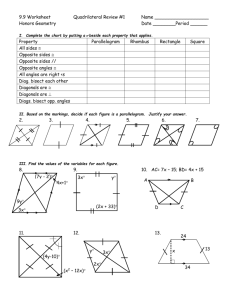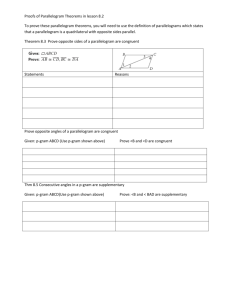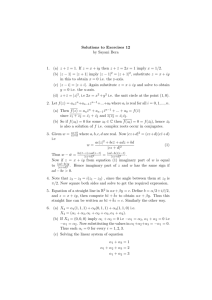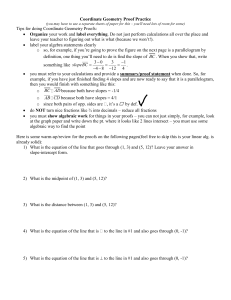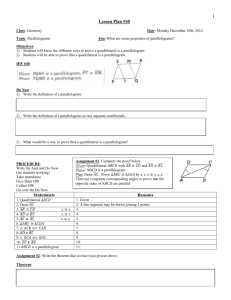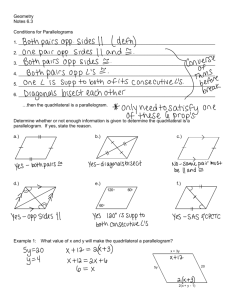Section 7.1
advertisement
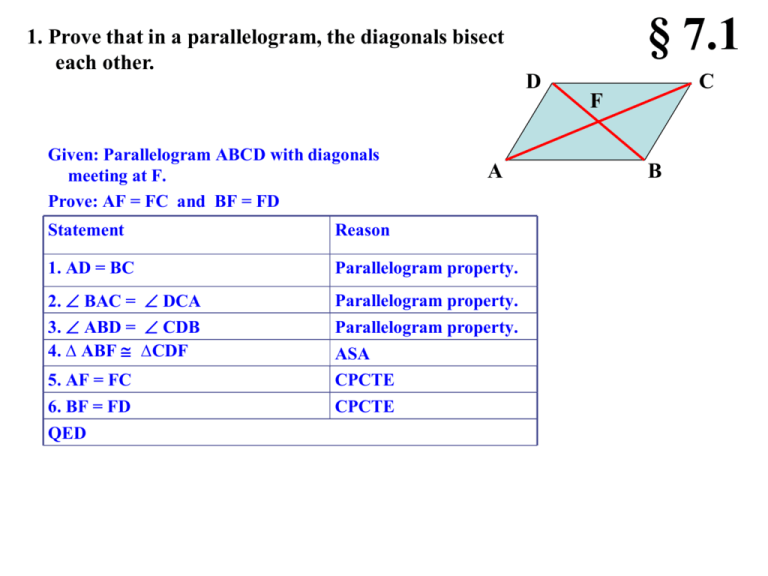
1. Prove that in a parallelogram, the diagonals bisect each other. Given: Parallelogram ABCD with diagonals meeting at F. Prove: AF = FC and BF = FD A Statement Reason 1. AD = BC Parallelogram property. 2. BAC = DCA 3. ABD = CDB 4. ∆ ABF ∆CDF Parallelogram property. Parallelogram property. 5. AF = FC 6. BF = FD QED ASA CPCTE CPCTE § 7.1 D C F B 2. Prove that a quadrilateral in which both pairs of opposite sides are congruent is a parallelogram. D C A B Given: Quadrilateral with AB = CD and BC = AD. Prove: Parallelogram Statement Reason 1. AC is diagonal Construction. 2. AB = CD and BC = AD 3. ∆ ABC ∆CDA Given SSS 4. D = B 5. ABCD parallelogram CPCTE Opposite angles congruent QED D 3. Prove that if the diagonals of a quadrilateral bisect each other, then it is a parallelogram. Given: Quadrilateral with AF = FC and BF = FD. Prove: Parallelogram Statement Reason 1. AF = FC AND BF = FD Given 2. AFD = CFB 3. ∆ AFD ∆CFB Vertical angles SAS 4. AD = BC 5. ∆ AFB ∆CFD CPCTE 6. AB = CD 7. ∆ AFB ∆CFD 8. ABCD is a parallelogram. QED C F A SAS CPCTE SAS Opposite sides equal. B D 4. Prove that in a rhombus the diagonals are perpendicular to one another. E A Given: Rhombus with diagonals Statement Reason 1. Diagonals bisect one another True of parallograms 2. 4 interior ∆s are all congruent 3. ∆ ABC ∆CDA SSS 4. 4 angles around E are all equal and thus 90º 5. AC BD QED SSS Thm. Def C B 5 Midpoint Connector Given: ΔABC, L and M midpoints. Prove: LM ∥ BC and LM = ½ BC (1) Extend LM to P so that LM = MP Construction SAS Alt inter s, A & ACP Construction Alt inter s SAS CPCTE Alt inter s, BCL & PLC (2) ALM ≅ CPM (3) AB ∥ PC (4) Construct LC (5) BLC ≅ PCL (6) LCP ≅ CLB (7) LM = ½ LP = ½ BC (8) LM ∥ BC A L B M P C 5 6. Prove that the perpendicular bisectors of the two diagonals and the four sides of a cyclic quadrilateral are concurrent. This one is easy. The four sides and the diagonals are all chords and the perpendicular bisectors of all chords go through the center of the circle. 7. Prove that the opposite angles of a cyclic quadrilateral are supplementary. This takes some knowledge of high school geometry and inscribed angles. An inscribed angle is equal in measure to ½ the intercepted arc. The two opposite angles intercept arcs that total the measure of the entire circumference of the circle. Thus the measure of the two opposite angles is ½ of 360 or 180 and thus they are cupplementary.
